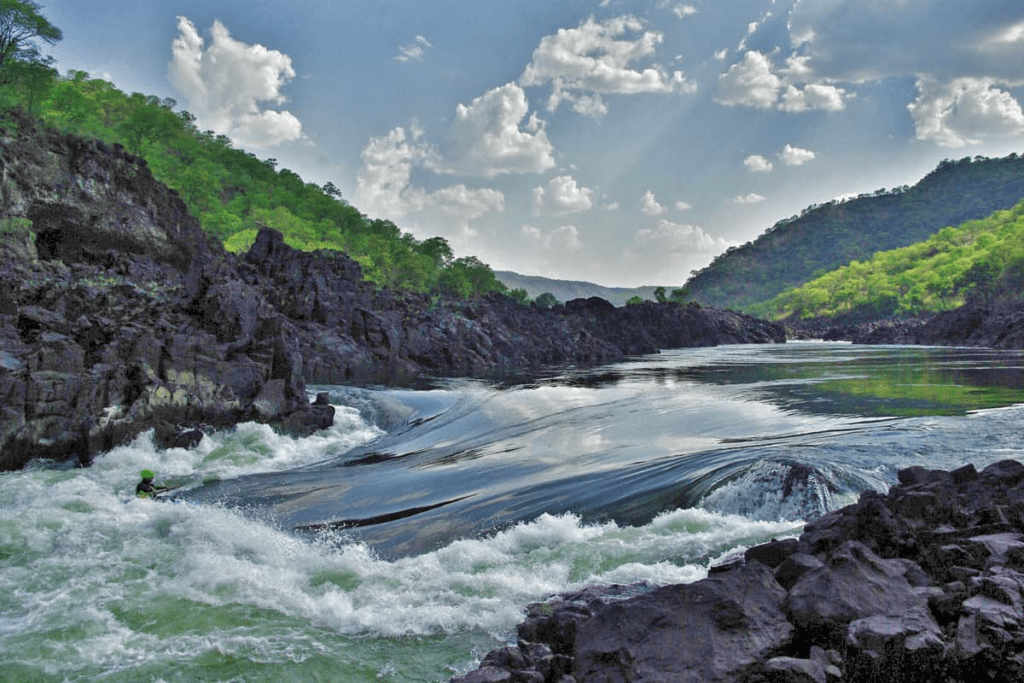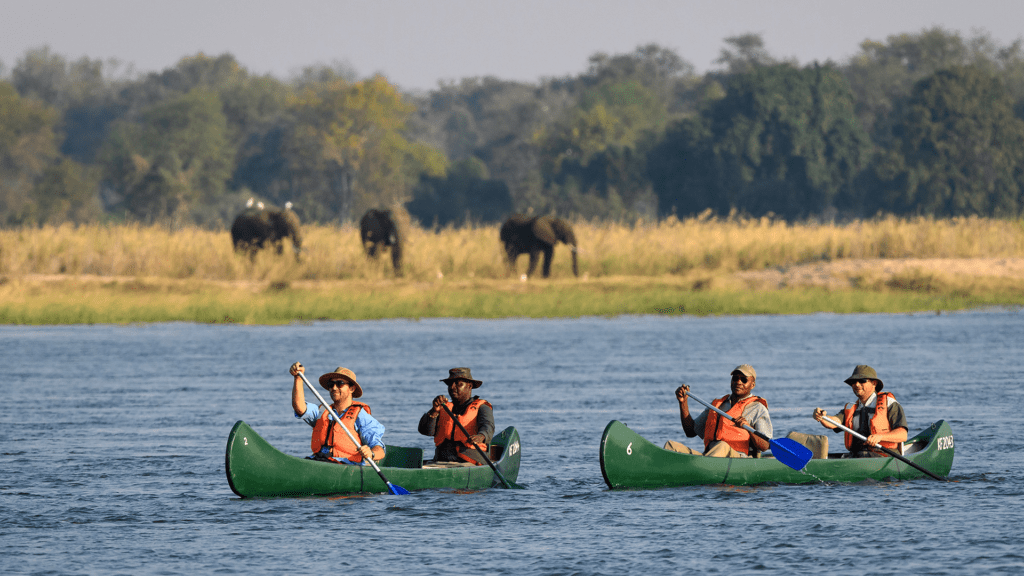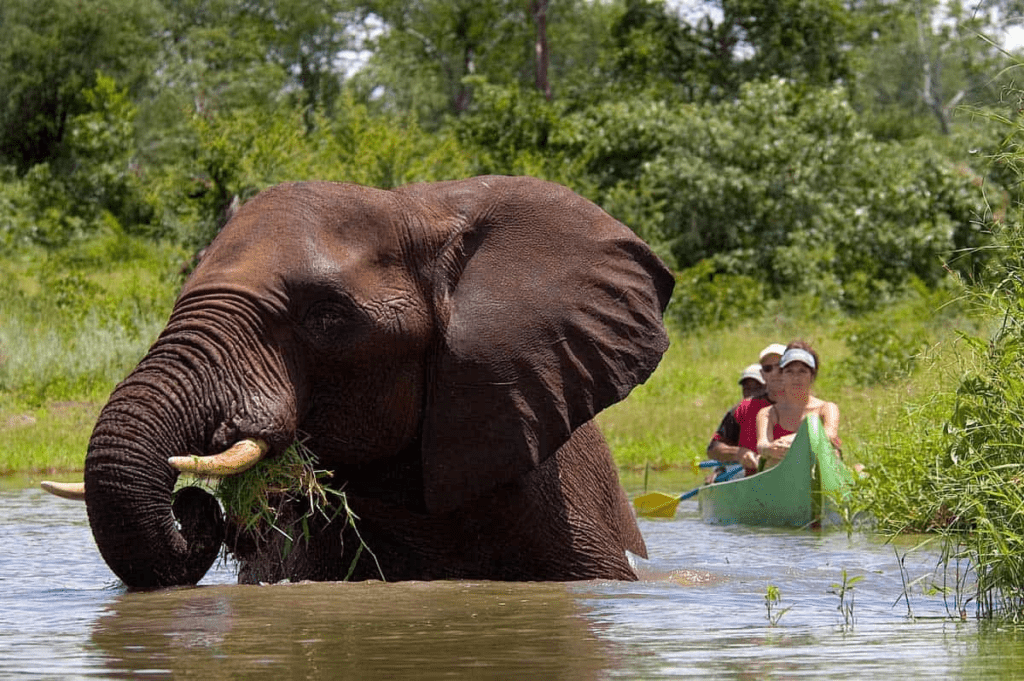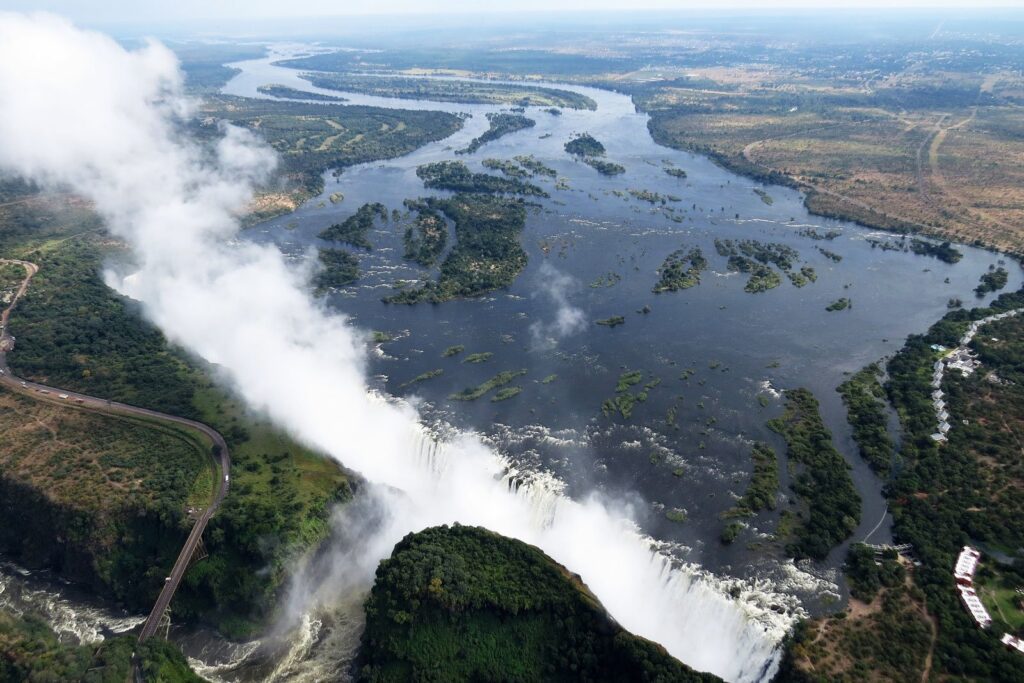The Zambezi River is more than just a river — it is the heartbeat of southern Africa. Flowing across six countries and carving one of the world’s most dramatic landscapes, this mighty waterway is home to Victoria Falls, abundant wildlife, ancient cultures, and unforgettable adventure. For the communities that live along its banks, the Zambezi is life itself — providing food, transport, identity, and a direct connection to nature.
Stretching over 2,700 kilometers, the Zambezi is the fourth-longest river in Africa and the only major African river that flows into the Indian Ocean. Along the way, it feeds wetlands, floodplains, gorges, and national parks, shaping ecosystems and travel experiences that are unlike anywhere else on the continent.
This guide explores the journey of the Zambezi — from its source to the falls, through its wild rapids and tranquil channels — and why it continues to attract explorers, photographers, conservationists, and travelers from all over the world.
Where Is the Zambezi River?
The Zambezi River begins its journey in northwestern Zambia, in a small forested area close to the border with Angola. From its source, it flows through or forms the border of six African countries: Zambia, Angola, Namibia, Botswana, Zimbabwe, and Mozambique, before finally emptying into the Indian Ocean on the coast of Mozambique.
It covers a vast stretch of over 2,700 kilometers, making it the longest east-flowing river in Africa. What makes the Zambezi unique is not just its size, but how much it offers along the way — from calm stretches ideal for fishing and canoeing, to violent rapids that draw white-water rafting enthusiasts from around the world.
One of the river’s most famous points is, of course, Victoria Falls, where the calm upper waters suddenly plunge over a basalt cliff into the Batoka Gorge, forming the world’s largest sheet of falling water. Downstream, the river continues its journey through deep gorges, wide floodplains, and remote wildlife areas.
Whether you see it from a canoe in the early morning, a riverside lodge deck at sunset, or from the sky in a microlight, the Zambezi River’s route is as much about beauty as it is about geography.
Zambezi River and Victoria Falls

The most famous moment in the journey of the Zambezi River comes when its calm upper waters reach the edge of a basalt plateau and plunge more than 100 meters into the deep Batoka Gorge. This is the point where the river creates one of the most spectacular natural wonders on Earth — Victoria Falls, known locally as Mosi-oa-Tunya, or “The Smoke That Thunders.”
Located on the border between Zambia and Zimbabwe, Victoria Falls is not the tallest or widest waterfall in the world, but it is the largest in terms of continuous curtain of falling water. During peak flow — typically between March and May — more than 500 million liters per minute roar over the edge, sending mist into the sky that can be seen from over 30 kilometers away.
The formation of Victoria Falls is the result of thousands of years of erosion and faulting along the Zambezi’s course. As the river carved its way through layers of volcanic rock, it created a series of gorges that now define the area below the falls. Today, the Zambezi enters this dramatic section in a wide, tranquil manner, only to drop suddenly and forcefully, creating an intense contrast between serenity and power.
The falls divide the Zambezi into two distinct sections: the Upper Zambezi, where the water flows more gently and is ideal for canoe safaris and sunset cruises, and the Lower Zambezi, which is known for wild rapids, rugged gorges, and remote safari regions. Victoria Falls is more than just a scenic highlight — it is the dramatic turning point in the river’s character.
Upper Zambezi vs Lower Zambezi
The Zambezi River is often divided into two key sections: the Upper Zambezi, which flows above Victoria Falls, and the Lower Zambezi, which begins after the water plunges into the Batoka Gorge. These two stretches offer completely different landscapes, moods, and travel experiences — each appealing to different types of explorers.
The Upper Zambezi
The Upper Zambezi is defined by wide, calm waters, dotted with lush islands, sandy channels, and riverine forests. This section of the river is ideal for relaxed activities such as canoe safaris, sunset cruises, fishing excursions, and birdwatching. Many of the luxury lodges on the Zambia side of the river are located here, offering tranquil settings just upstream from the dramatic drop of Victoria Falls.
In this peaceful stretch, it’s not uncommon to spot elephants crossing the river, hippos wallowing in shallow bays, and kingfishers diving for prey. The Upper Zambezi offers a more serene and scenic experience, making it especially popular with couples, families, and those looking to unwind in nature.
The Lower Zambezi
In contrast, the Lower Zambezi begins where the river crashes into the Batoka Gorge. Here, the landscape becomes rugged and steep, the water accelerates, and the river carves through narrow canyons bordered by cliffs. This stretch is home to some of the world’s best white-water rafting, with rapids named “Oblivion” and “The Washing Machine” offering thrilling challenges.
Further downstream, the river opens up again, forming the Lower Zambezi National Park in Zambia and Mana Pools National Park in Zimbabwe — both known for incredible wildlife viewing along the riverbanks. The Lower Zambezi is wilder, more remote, and better suited to adventure travelers and safari purists seeking off-the-beaten-path experiences.
Together, the Upper and Lower Zambezi represent two sides of the same river — one tranquil and reflective, the other fierce and untamed — both offering unique ways to connect with nature in its purest form.
Top Activities on the Zambezi River

The Zambezi River isn’t just one of Africa’s most scenic rivers — it’s also a playground for some of the continent’s most unforgettable travel experiences. Whether you’re after high-adrenaline adventures or peaceful nature encounters, the river offers activities for every type of traveler.
White-Water Rafting
The stretch of river just below Victoria Falls is considered one of the best places in the world for white-water rafting. With a series of Class IV and Class V rapids winding through the Batoka Gorge, rafting here is both intense and spectacular. The dry season months from August to December offer the safest and most thrilling conditions.
Canoe Safaris
For a quieter way to explore the river, canoe safaris on the Upper Zambezi allow travelers to glide through narrow channels, past islands and bird-filled trees. These guided trips are ideal for spotting hippos, crocodiles, elephants, and countless bird species — all while floating peacefully downstream.
Sunset Cruises
One of the most popular experiences on the Upper Zambezi is the sunset cruise. These relaxed, late-afternoon journeys offer open views of the river and often include drinks, snacks, and commentary from experienced guides. As the sun dips below the horizon and silhouettes animals at the water’s edge, the river turns golden — a moment many visitors call the highlight of their trip.
Devil’s Pool and Livingstone Island
During the dry season, the Zambezi’s reduced flow allows access to Livingstone Island and the world-famous Devil’s Pool — a natural rock pool perched right on the edge of Victoria Falls. Guests can swim under guided supervision and look directly over the edge of the falls, making it one of the most exhilarating experiences anywhere in Africa.
Sport Fishing
The Zambezi River is a major destination for tiger fishing, especially on the Upper Zambezi where the calm waters create ideal conditions. Anglers from around the world come to catch (and release) the tigerfish — known for its fierce fight and impressive teeth.
Birdwatching and Photography
With over 400 species of birds recorded along the Zambezi, the river is a paradise for birders and photographers alike. Species like the African fish eagle, kingfisher, heron, and bee-eater are frequently seen, especially in the early morning or late afternoon light.
Zambezi River Wildlife

The Zambezi River is a lifeline for some of southern Africa’s most iconic wildlife. Along its winding course, the river supports a rich and diverse ecosystem that changes with the seasons — from floodplains and reed beds to deep gorges and forested banks. For travelers seeking close encounters with Africa’s wild beauty, the Zambezi delivers in every direction.
Hippos and Crocodiles
Two of the river’s most common and impressive residents are the hippopotamus and the Nile crocodile. Hippos are often seen in pods, resting in the water by day and grazing on land by night. Crocodiles sunbathe on riverbanks or glide silently below the surface, especially in the warmer months. They are key indicators of the river’s health and play important roles in the aquatic ecosystem.
Elephants Along the Shore
In the Upper Zambezi, especially near Zambezi National Park and Lower Zambezi National Park, elephants are frequently spotted crossing the river or cooling off in its shallows. They often move in small family groups, and their presence adds a dramatic and unforgettable element to any canoe safari or river cruise.
Birds of the Zambezi
With more than 400 bird species recorded along the river, the Zambezi is one of Africa’s premier birdwatching destinations. Among the most iconic are the African fish eagle, often seen perched on a high branch before swooping down for a catch, and the lilac-breasted roller, known for its vibrant feathers and agile flight. Bee-eaters, kingfishers, herons, and hornbills are also common sights along the riverbanks.
Other Wildlife Highlights
Waterbuck, bushbuck, and impala often graze close to the river, while baboons and vervet monkeys can be seen leaping between trees or foraging near the water. In the Lower Zambezi, the surrounding woodlands are home to leopards, buffaloes, and occasionally lions, making the area ideal for combined river and land-based safaris.
Whether you’re drifting past a pod of hippos in the early morning or watching elephants gather at sunset, the wildlife along the Zambezi River is never far away — and never ordinary.
Cultural and Historical Importance of the Zambezi River
For centuries, the Zambezi River has shaped not only the landscapes of southern Africa, but also the cultures, traditions, and histories of the people who live along its banks. In many communities, the river is far more than a natural resource — it is a spiritual force, a provider, and a keeper of ancestral stories.
Zambezi River Traditional Significance
In Zambia and Zimbabwe, local tribes such as the Tonga and Lozi people have long considered the Zambezi sacred. The river features prominently in folklore and oral history, often viewed as the home of water spirits and ancient gods. Ceremonies are still held to honor the river, particularly during the seasonal floods that are seen as both a blessing and a challenge.
For fishermen, farmers, and villagers, the Zambezi is essential for survival. It provides fish for food, water for crops, and a mode of transportation between otherwise remote areas. Crafts such as canoe carving, basket weaving, and traditional fishing techniques have been passed down through generations, all tied to the rhythm of the river.
Exploration and the Colonial Era
In the mid-19th century, the Zambezi River became one of Africa’s most explored waterways, most famously by Dr. David Livingstone, the Scottish missionary and explorer. In 1855, he became the first European to witness Victoria Falls, naming it in honor of Queen Victoria — though he acknowledged the local name Mosi-oa-Tunya, meaning “The Smoke That Thunders.”
Livingstone’s journey along the Zambezi marked a new chapter in the river’s history, opening the region to missionaries, traders, and later, colonial influence. His legacy remains strong in Livingstone, Zambia, where a museum and statue near the falls commemorate his travels.
The Zambezi River Today
Today, the Zambezi continues to serve as a link between past and present. It connects rural villages and modern towns, supports both traditional livelihoods and international tourism, and remains a symbol of resilience and identity for millions of people. For travelers, learning about the river’s cultural roots offers a deeper connection to the region — one that goes beyond landscapes and wildlife.
Conservation and Sustainable Travel Along the Zambezi River
The Zambezi River is not only a natural treasure — it’s also an ecosystem under pressure. From climate change and hydropower projects to overfishing and increasing tourism, the river faces challenges that threaten both its wildlife and the communities who rely on it. However, growing awareness around sustainable travel and community-based conservation is helping protect the Zambezi for future generations.
Protecting the River’s Ecosystems
Conservation efforts along the Zambezi focus on protecting sensitive habitats and endangered species. Wetlands, floodplains, and forested riverbanks support a vast web of biodiversity, and these areas are closely monitored by both government agencies and non-profit organizations. In the Zambezi National Park and Lower Zambezi National Park, anti-poaching patrols, controlled tourism zones, and community ranger programs are key components of ecosystem management.
Collaborative efforts between Zambia and Zimbabwe are also working to limit illegal fishing, safeguard nesting grounds for birds, and reduce human-wildlife conflict in border regions.
Sustainable Lodges and River Experiences
Many of the lodges and tour operators on the Zambezi have embraced eco-conscious practices — using solar energy, sourcing food locally, and building with minimal impact on the environment. Travelers can support sustainability by choosing accommodations that follow responsible tourism guidelines, employ local staff, and reinvest in conservation or education projects.
Canoe safaris, walking safaris, and catch-and-release fishing are excellent ways to enjoy the river without harming its natural balance. Some tour providers also include visits to local villages or conservation centers, helping guests understand the relationship between wildlife protection and community well-being.
How Travelers Can Help
Small choices by visitors can make a big difference. Respecting wildlife, reducing plastic waste, tipping local guides, and supporting ethical souvenir purchases all contribute to a more sustainable travel experience. And by learning about the river’s importance before and during your trip, you become part of the growing movement to protect the Zambezi — not just as a destination, but as a way of life.
Best Time to Visit the Zambezi River
The Zambezi River offers different experiences depending on the time of year, shaped by seasonal rainfall and changing water levels. Knowing when to visit can make a big difference in the kind of activities you’ll enjoy and the scenery you’ll encounter.
Dry Season (May to October)
The dry season is considered the best time to visit the Zambezi River, especially for adventure activities and wildlife viewing. From June to early November, water levels drop, revealing sandbanks and making the river calmer in the upper stretches. This is when white-water rafting reaches its peak, and Devil’s Pool opens for guided swimming on the edge of Victoria Falls.
Lower water levels also improve visibility of the falls themselves, while offering cooler mornings, sunny afternoons, and ideal safari conditions along the riverbanks. Sunset cruises, fishing trips, and walking safaris are especially popular during this time.
Wet Season (November to April)
The wet season brings heavy rainfall across the Zambezi River basin, raising water levels and turning the surrounding landscapes green and vibrant. This period offers dramatic views of Victoria Falls at full flow — especially from February to April — though some river activities may be limited or closed for safety reasons.
Travelers visiting during this season enjoy lush scenery, excellent birdwatching, and fewer crowds. It’s also a great time for photography, especially with the high mist and occasional rainbows over the falls. However, rafting trips and Devil’s Pool are usually paused until water levels drop again.
Conclusion: Why the Zambezi River Belongs on Every Traveler’s Map
The Zambezi River is not just a river — it is the pulse of an entire region. From its quiet channels and riverside forests to the roaring plunge of Victoria Falls, the Zambezi connects landscapes, wildlife, and people in ways few other places on Earth can match. Whether you’re drawn by the thrill of rafting through gorges, the calm of a sunset cruise, or the humbling view of elephants along its banks, the river offers an experience that is both timeless and unforgettable.
For travelers seeking something deeper — a journey that moves beyond sightseeing into meaning, memory, and connection — the Zambezi delivers. It invites you to slow down, to listen to the call of the fish eagle, and to share in the rhythm of Africa’s natural heart.
Let us help you explore the best of the Zambezi, from handpicked river lodges and guided canoe safaris to family-friendly activities and custom itineraries that flow with the river itself.
Start your journey on the Zambezi today.
[Plan Your Trip] | [Explore Zambezi River Experiences] | [Contact Our Local Experts]



